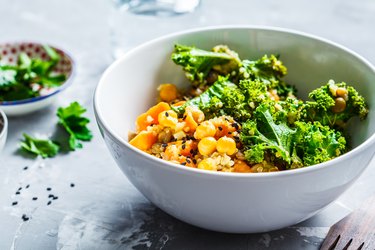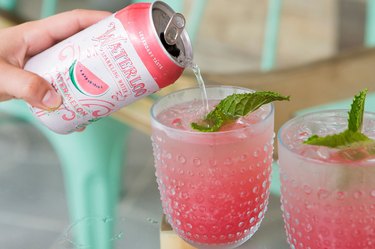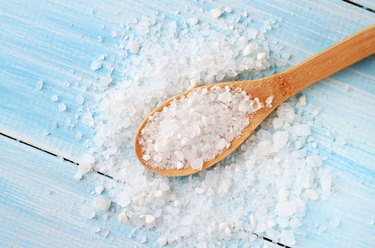
From pregnancy to ill-fitting shoes or a long day on your feet, there are many reasons why you may experience occasional swelling in your lower legs.
Swollen feet usually signal the presence of edema, a symptom that occurs when your body tissues retain too much fluid. Fortunately, there are things you can do to pamper your puffy feet and reduce the swelling. One simple strategy involves being mindful of what you put on your plate. Yep, the foods you eat can either help (or hinder) swollen legs.
Video of the Day
Video of the Day
Here, DJ Blatner, RDN, author of The Superfood Swap: The 4-Week Plan to Eat What You Crave Without the C.R.A.P., shares which foods may soothe the swelling and which to skip (or limit) to avoid increased puffiness.
Warning
If you experience chronic foot swelling, see your doctor for an evaluation as this could be an indication of a more serious underlying health issue such as heart, kidney, liver or vascular problems.
Foods That Improve Swelling
1. Water-Rich Foods
While consuming more water sounds counterintuitive when your feet are full of excess fluid, it's actually exactly what you need to slash the swelling.
That's because dehydration could be the reason your dogs are so swollen in the first place.
"When you are dehydrated, your body may hold onto the water it already has to make up for the lack of incoming H2O," Blatner says. "Usually, you'll see this water retention most in extremities like feet," she adds.
Staying properly hydrated is the most solid strategy for steering clear of swelling in the feet. Water also helps your system get rid of excess sodium, which can produce puffy feet (more on this later), and other waste products, according to the Cleveland Clinic.
And you don't need to guzzle a glass a H2O for these anti-swelling benefits. Though "drinking water is important, high-water foods also count toward hydration," Blatner says.
Water-rich foods include: All fresh fruits and vegetables, specifically watermelon, berries, oranges, cucumbers, lettuce, celery, tomatoes
Broth-based soups can serve as stellar hydrators too, Blatner says.
Tip
The color of your urine can help reveal if sufficiently hydrated, Blatner says. A light-yellow hue means you’re getting enough water. Another good rule of thumb is “aiming to drink about half of your body weight (in pounds) in ounces of water each day,” she says.
2. Foods Full of Electrolytes
"Electrolytes such as magnesium, potassium and calcium help to balance the sodium in our body," Blatner says. And this is especially important since swelling can be caused by an excess of sodium in your system.
To prevent or minimize foot swelling, feast on foods that contain the following electrolytes:
Potassium
Potassium helps your body regulate the amount of fluid inside your cells and excrete sodium, according to the Harvard T.H. Chan School of Public Health. It also facilitates muscle contractions and relaxes blood vessels, which is why it supports healthy blood pressure.
Potassium-rich foods include: bananas, potatoes, sweet potatoes, avocado, beets, coconut water
Calcium
Like other electrolytes, calcium not only helps your body maintain the right balance of water, but it also transports nutrients into your cells (and waste out of them) and supports the proper functioning of your nerves, muscles, heart and the brain, according to the U.S. National Library of Medicine.
Calcium-rich foods include: dairy (like milk, yogurt, cheese, kefir, etc.), broccoli, kale, canned salmon and sardines, tahini
Magnesium
Since magnesium plays a pivotal part in moving calcium and potassium ions across cell membranes, it's also essential for proper fluid balance (as well as nerve function, muscle contraction and a healthy heart rhythm), according to the National Institutes of Health (NIH).
In fact, retaining too much water, along with the subsequent swelling, can signal a magnesium deficiency, per the Cleveland Clinic.
Magnesium-rich foods include: spinach, pumpkin seeds, chia seeds, almonds, dark chocolate
Foods That Worsen Swelling
While some foods can help prevent or reduce puffy feet, others can make swelling worse. Skip or limit the following foods that can lead to swelling in your lower extremities.
1. High-Sodium Foods
"When you eat too much salt, your body will hold onto extra water to maintain the proper sodium-to-water balance," Blatner says. Frequently, the feet are the body part where you'll experience this fluid retention due to high-sodium foods.
To avoid this sodium-induced swelling, keep an eye on your salt intake. In particular, "aim to limit the 'salty six' — lunchmeat, bread/rolls, sandwiches, pizza, soup and burritos/tacos," Blatner says.
High salt intake not only increases foot swelling but also raises your risk of high blood pressure, which can contribute to heart disease, per the Harvard T.H. Chan School of Public Health.
Here are some other tried-and-true tips to slash sodium in your diet:
- Always read the nutrition info on food labels. Look for foods that have less than 20 percent your daily value (DV) of sodium per serving, Blatner says.
- Dine out less: A lot of sodium in our daily diet comes from eating restaurant foods, Blatner says. You can curb this by cooking at home more often.
- Choose whole foods over processed: Most Americans consume approximately 3,300 milligrams of sodium per day, and nearly three fourths of it comes from processed foods, according to the Harvard T.H. Chan School of Public Health. In place of processed fare, opt for fresh fruits and vegetables, whole grains and healthy lean proteins like legumes.
2. Refined Carbs and Sugary Foods
"Excess carbohydrates, specifically those like refined carbs and sugary foods, can cause the body to hold onto water," Blatner says. Though this is more likely to lead to belly bloat than foot swelling, it's always a good idea to cap the amount of refined carbs in your eating plan.
Indeed, research shows that consuming too many low-fiber refined carbohydrates and added sugars can instigate chronic inflammation, according to the Cleveland Clinic. And chronic inflammation in the body is associated with an increased risk of developing diseases such as diabetes.
Tip
In addition to getting the proper nutrition, remember to move your body to keep foot swelling in check. “Without enough activity, blood can’t flow as easily and will pool in one place, especially the feet, due to gravity,” Blatner says.
“If you know you are going to be standing or sitting for long periods of time, set an alarm to regularly make sure you move,” she says. This will get the blood pumping and prevent it from pooling in your lower limbs.
Massaging your tired dogs at the end of the day can also help redistribute the swelling, she adds.
- Harvard T.H. Chan School of Public Health: “Potassium”
- National Library of Medicine: “Fluid and Electrolyte Balance”
- National Institutes of Health: “Magnesium”
- Cleveland Clinic: “Swollen Feet and Ankles: Treatments to Try”
- Cleveland Clinic: “5 Foods That Can Cause Inflammation”
- FamilyDoctor.org: Edema
Was this article helpful?
150 Characters Max
0/150
Thank you for sharing!
Thank you for your feedback!
Is this an emergency? If you are experiencing serious medical symptoms, please see the National Library of Medicine’s list of signs you need emergency medical attention or call 911.


